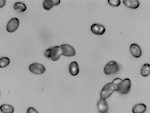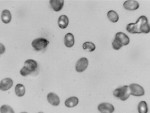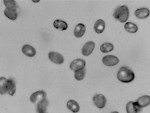Elmer: Is this a Melanoleuca -- found in a pine forest -
but there were other trees around
It had a flaky, chalk like feel when touched
Sava: Amanita smithiana. The ring is often missing.
A. silvicola is similar; the main difference being the rooting habit of smithiana.
And it seems that your mushroom did have a "root" that got broken when you picked it.
Katie: Oh yes, I was thinking about an amanita too. I agree with Sava.
Elmer: The gills were definitely adnate. (see the pictures)
Can this still be an Amanita?
Sava: Description from MatchMaker:
LATIN NAME(S) Amanita smithiana Bas Persoonia 5: 418. 1969
ENGLISH NAME(S) Smith's Amanita
NOTES features include white color, tall stature, cap with cottony indistinct warts,
ragged scaly stem with spindle-shaped bulb that is often rooting, poorly developed ring,
volva with concentric zones, mild to pungent odor, and conifer habitat in or near
rotten wood; common, collections examined from BC, WA, OR, ID, CA, NM, (Tulloss(3)),
also found in Mexico (Tulloss(5)),
CHEMICAL REACTIONS paracresol test for tyrosinase positive except in base of bulb and in gills,
with strongest reaction in top third of stem, syringaldazine test for laccase positive
in a line parallel to cap cuticle and about 0.2cm below it in cap flesh,
also in spots on gills and very tip of bulb, (Tulloss(3))
CAP 5-17cm across, hemispherical then convex to flat-convex,
sometimes subumbonate [somewhat umbonate], margin decurved [downcurved] at first,
finally flaring upward when old, margin projecting slightly beyond gills;
cap "white or whitish or ivory, sometimes becoming pale tan in dry weather,
infrequently with pinkish staining, sometimes yellowish on margin from handling or drying",
subviscid [slightly viscid] at first, remaining tacky when moist, becoming shiny on drying,
and developing kid leather texture, margin non-striate,
appendiculate with dense white floccose submembranous [somewhat membranous] material; universal veil
"white to whitish to pale buff to pale pinkish buff to cream buff to tan to brownish",
darker colors apparently attributable to warm dry weather and/or age, occurring as
floccose/felted patches or occasionally as easily crushed, subpyramidal or subconical
warts especially over disc, in either case reduced to unevenly distributed,
finer flocculence toward margin, removable as long as cap remains moist, (Tulloss(3))
FLESH up to 1.5-2cm thick at stem, thinning evenly to margin; in both cap and stem white,
and unchanging when cut or bruised, (Tulloss(3))
GILLS free to narrowly adnate, sometimes with a faint decurrent line on stem apex, close
to crowded, 0.6-1.1cm broad, broadest about halfway from stem to cap margin, rarely forking,
subgills "truncate to rounded truncate (short ones) or attenuate (longer ones),
often unevenly distributed" among gills; "white to cream to ivory to pale pinkish buff in mass,
in side view clay white or occasionally translucent, sometimes becoming cream in age";
edge white fringed-flocculose, (Tulloss(3))
STEM 6-16cm x 1.0-3.5cm, equal or widening downward, "usually solid, occasionally with a short hollow lumen,
commonly lacking insect tunnels",
bulb broadly or narrowly fusiform [spindle-shaped], up to 13cm or more long and up to 5.5cm wide,
with occasional extended root-like projection that is very difficult to collect in its entirety,
but may be 30cm long; stem "white, bruising slowly buff to pinkish buff where handled";
"decorated with floccose/squamulose zones that can disappear with age and with fibrils that
may become somewhat brownish", VOLVA in broken concentric rings of irregular warts at top of bulb,
detersile [removable], (Tulloss(3))
VEIL on stem universal veil in broken rings of irregular warts at top of bulb,
removable; partial veil as floccose-fibrillose-submembranous ring, superior, ragged, or lacerate, (Tulloss(3))
ODOR absent to mild to somewhat faintly pungent or salty or like dust from ground bark of Douglas fir, to yeast-like or with cut surfaces smelling like green tomatoes or tomato plants, very strong and unpleasant when old, almost ham-like with tinges of chlorine, (Tulloss(3))
TASTE mild to somewhat sweet or lacking; when cooked: radish-like, superb to moderately acidic bitter, (Tulloss(3)), [do not taste]
EDIBILITY poisonous, in a number of poisonings A. smithiana has been considered a possible cause with the following picture: after 4-10 or more hours, gastrointestinal symptoms, followed by kidney failure with or without liver failure, (Tulloss(3))
HABITAT single to gregarious, usually under conifers, often amidst or near very rotten wood; fruiting in fall, occasionally summer, winter, spring (September to December, occasionally July, August, or January, once collection in May), (Tulloss(3)), fall, winter, spring, summer
SPORE DEPOSIT white to pale cream (Tulloss(3))
MICROSCOPIC spores (6.5)8.5-12.0(16.0) x (4.3)5.8-7.9(10.8) microns, elliptic to elongate, often adaxially flattened, sometimes swollen at one end, smooth, amyloid, contents guttulate or granular; basidia dominantly 4-spored, occasionally 1-spored, rarely 2- or 3-spored, 43-70 x 8.5-13.8(15.0) microns, thin-walled, slenderly clavate, clamps and proliferated clamps rather common, (Tulloss(3))
NAME ORIGIN
SIMILAR like A. silvicola with its white color and ragged or shaggy stem, but stem of A. smithiana more likely to be rooting and spindle-shaped (as opposed to marginate or clavate), odor may be unpleasant, warts are formed on cap rather than patches (but may not be distinct), usually taller especially when young, clamp connections present on basidia, somewhat smaller spores, lack of chains of inflated cells in universal veil remnants on cap, and positive chemical reaction of cut stem to syringaldazine and to paracresol; like Tricholoma magnivelare but 1) odor different, 2) large distinctive stem scales absent, 3) ring usually poorly developed or ragged, and 4) shape tends to be tall and thin rather than squat and robust; like Amanita cokeri but poorly developed ring, cottony to scaly stem surface, and cap lacks the distinct warts of Amanita cokeri; in earlier years often mistakenly identified as A. solitaria or A. chlorinosma
SOURCES Tulloss(3), Tulloss(5), Lincoff(2)*, Ammirati(1)*, Lindgren(1), Trudell(4)*, Sept(1)*
FAMILY Amanitaceae of Order Agaricales
Elmer: Thanks,
From the Quick Key I wrongfulness concluded that Amanitas have free gills.
Clearly one need be very careful to realize that the "Easy Key" does not mean
"has", instead it means "most of the time has".
Katie: Could it be a Lactarius. Lactarius Luteolus? Those have a fishy odor but they are velvety.








































